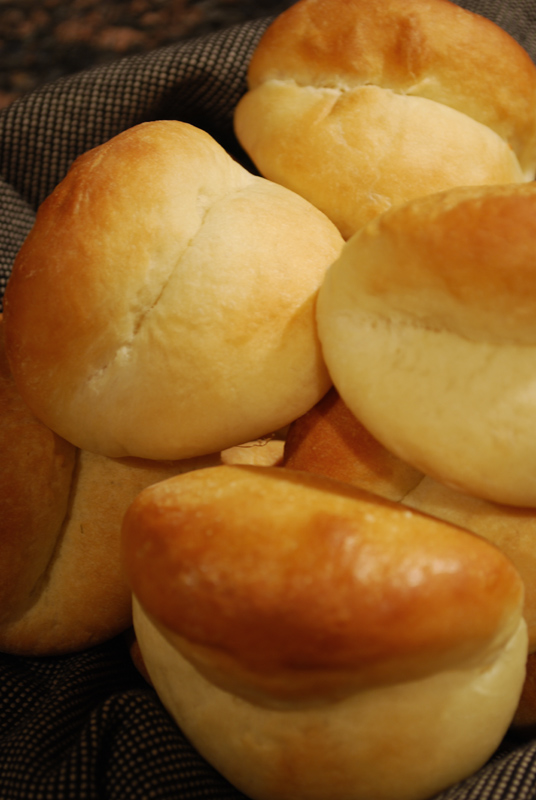Week Seven: American Breads
Americans seem to have a sick sort of love affair with soft-crusted, lightly-sweetened, rich-dough white bread. Personally, I’ll take that crusty baguette any day; but there is a reason breads like these Parker House Rolls became so popular – they’re pretty darn good, when they’re done right.
To refresh your culinary history memory: for a long stretch of time in early America, there was very little flour available to cook with; and what little there was had a high price tag, due to the trouble and expense of shipping it over from Europe. Resourceful cooks learned how best to handle the most abundant grain, corn, by playing to its strengths and turning it into various quick breads.
Yeast breads were more uncommon, and didn’t have a resurgence until wheat agriculture took off.
But the American palate had by then become accustomed to a softer bread; and in fact wouldn’t recover a taste for a harder crust until the recent artisan food movement, kicked off by Alice Waters in the 1970’s. Hence, soft and pillowy dinner rolls have been de rigeur on American tables for about as long as America itself has been around. Parker House rolls themselves appeared in the 1870’s, at the posh Parker House Hotel in Boston. They are one of those rare foods whose origins can be traced to a specific time and place. The story of its creation has (of course) been lost to time, but tales generally involve an angry chef grabbing handfuls of made-up rolls, and slamming them into a hot oven. With no time to make more, he was forced to serve them, and they were a hit. (Me, I can’t exactly see any chef worth his apron literally throwing anything into an oven and then serving it, but it does make for a good story.)
The unique shape is what sets these rolls apart: they are rounded, or cut out of a thick sheet of dough, then flattened in the middle, and folded over to make a sort of clamshell shape. As they rise and bake, they puff and open up a little, making for more surface area to turn into a lovely crust. The dough usually contains milk and butter, and is slightly sweetened. When made correctly, it tastes rich and light at the same time, soft and gently chewy, and just plain good.
So, yes; generally speaking, I prefer a crisp crust on my bread, with a leaner dough underneath. But that sort of dough just won’t work well in this make-up. To handle all the rolling and folding and crimping, you need a soft bread that can take that abuse, and not get its gluten all in knots. And when you pull those little darlings out of the oven, all golden brown, and almost literally smiling at you… well, even I wouldn’t be able to turn one down. Could you?
Parker House Rolls
From The Joy of Cooking
Makes 18 rolls
2 1/4 teaspoons active dry yeast (1 package)
3 tablespoons warm water (105º – 115º F)
1 cup warm milk (105º – 115º F)
5 tablespoons melted unsalted butter
3 tablespoons sugar
1 large egg
1 teaspoon salt
2 cups bread flour
1 1/2 – 2 cups all-purpose flour
Melted butter or milk for brushing on rolls
1. Combine yeast and warm water in a large bowl or in the bowl of an electric mixer and let stand until the yeast is dissolved, about 5 minutes.
2. Add the warm milk, melted butter, sugar, egg, and salt. Mix by hand, or on low speed, for 1 minute.
3. Gradually stir in the bread flour, and then add the all-purpose flour until the dough is moist but not sticky. Knead for about 10 minutes by hand or with the dough hook of your mixer on low to medium speed, until the dough is smooth and elastic.
4. Transfer the dough to an oiled bowl and turn it over once to coat with oil. Cover loosely with plastic wrap and let rise in a warm place until doubled in volume, 1 to 1 1/2 hours.
5. Divide the dough equally into 18 pieces (just over 1 ounce each). On an unfloured surface, roll the dough pieces into balls, covering the remaining dough. Loosely cover the balls with plastic wrap and let rest for 10 minutes.
6. Grease a large baking sheet, or line with parchment paper. With a rolling pin, roll just the center of each round to create an oval (do not roll over the edge as the edges should be slightly thicker than the center).
7. Brush the tops lightly with melted butter and fold the ovals in half so the two elongated ends meet. Place the rolls in rows 2 inches apart on the baking sheet. Cover with oiled plastic wrap and let rise in a warm place until doubled in volume, about 1 hour.
8. Preheat the oven to 425º F. Brush the tops of the rolls with melted butter or milk. Bake until golden brown, about 15 minutes.
Notes:
1. I used olive oil instead of butter for brushing on the tops of the rolls. It worked just fine. I did, however, use milk on the tops.
2. I don’t think I rolled mine out flat enough, since they all opened up while rising. I think these rolls are supposed to be fairly clamshell-shaped, and mine turned out looking a bit like wax lips. But whatever floats your boat, right?

